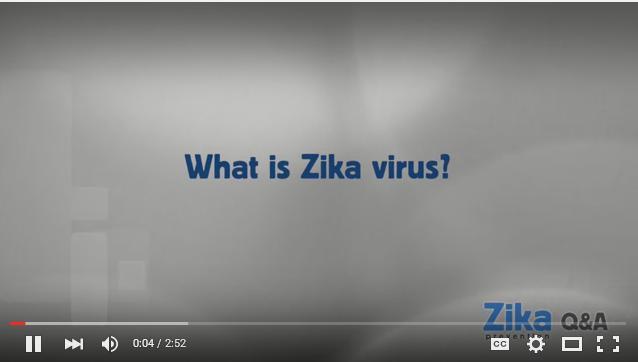Zika virus
Zika virus
Zika virus is an emerging mosquito-borne virus. The Zika virus was first isolated in 1947 from a monkey in the Zika forest of Uganda.
Key facts
- Zika virus disease is caused by a virus transmitted by Aedes mosquitoes (which usually bite during the morning and late afternoon/evening hours).
- People with Zika virus disease usually have a mild fever, skin rash (exanthema) and conjunctivitis. These symptoms normally last for 2-7 days.
- There is no specific treatment or vaccine currently available.
- The best form of prevention is protection against mosquito bites.
- The virus is known to circulate in Africa, the Americas, Asia and the Pacific.
Causes
Zika virus is transmitted to people through the bite of an infected mosquito from the Aedes genus, mainly Aedes aegypti in tropical regions. This is the same mosquito that transmits dengue, chikungunya and yellow fever.
Symptoms
Zika virus usually causes mild illness; with symptoms appearing a few days after a person is bitten by an infected mosquito. Most people with Zika virus disease will get a slight fever and rash. Others may also get conjunctivitis, muscle and joint pain, and feel tired. The symptoms usually finish in 2 to 7 days.
Potential complications
Arrival of the virus in some places has been associated with a steep increase in the birth of babies with abnormally small heads (microcephaly) and in cases of Guillain-Barre syndrome. A causal relationship between Zika virus infection and birth malformations and neurological syndromes has not yet been established, but is strongly suspected.
Diagnosis
Zika virus is diagnosed through PCR (polymerase chain reaction) and virus isolation from blood samples. Diagnosis by serology can be difficult as the virus can cross-react with other flaviviruses such as dengue, West Nile and yellow fever.
Prevention
Mosquitoes and their breeding sites pose a significant risk factor for Zika virus infection. Prevention and control relies on reducing mosquitoes through source reduction (removal and modification of breeding sites) and reducing contact between mosquitoes and people.
This can be done by using insect repellent; wearing clothes (preferably light-coloured) that cover as much of the body as possible; using physical barriers such as screens, closed doors and windows; and sleeping under mosquito nets. It is also important to empty, clean or cover containers that can hold water such as buckets, flower pots or tyres, so that places where mosquitoes can breed are removed.
Special attention and help should be given to those who may not be able to protect themselves adequately, such as young children, the sick or elderly.
During outbreaks, health authorities may advise that spraying of insecticides be carried out.
Travellers should take the basic precautions described above to protect themselves from mosquito bites.
Treatment
Zika virus disease is usually relatively mild and requires no specific treatment. People sick with Zika virus should get plenty of rest, drink enough fluids, and treat pain and fever with common medicines. If symptoms worsen, they should seek medical care and advice. There is currently no vaccine available.
Source : World Health Organisation
Is it Zika virus, dengue, chikungunya, or malaria
These diseases share many of the same signs like fever, aches, and rash. It is also possible to be infected by more than one at the same time. Some signs help point to one disease over another.
- Malaria: Usually starts with chills (shivering), a headache, and then a high fever (40°C/104°F) for 2 or 3 days. The person then may go back and forth between having a fever and then chills again. Malaria does not give a rash.
- Dengue: Gives a high fever (40°C/104°F) that comes on suddenly and can last up to a week. Usually 2 or more of these signs with the high fever means dengue: severe muscle and joint aches, headache and pain behind the eyes, nausea or vomiting, or a rash. Watch out for vomiting blood, unusual swelling, or bleeding from the nose, gums, or skin as these can be signs of a dangerous type of dengue where emergency help is needed.
- Chikungunya: Usually there is a mild fever and very intense joint pain that may affect the hands, feet, knees, and back. The joint pain can be so painful that people stay bent over and cannot walk. After the fever goes away, the joint pain can last for several more weeks, or even months.
- Zika: Gives a mild fever and usually a rash. It is also common to have irritated eyes or “pink eye” (conjunctivitis).
A 24*7 Control Room for providing information on Zika Virus Disease is now operational at the Ministry of Health & Family Welfare, Government of India. The numbers of the Control Room are 011-23061469 and 23063205.
Related Resources
- Action plan for managing Zika Virus Disease
- Communicable Disease Alert on Zika Virus
- Guidelines on Zika Virus Disease following Epidemic in Brazil and other countries of America
- Guidelines for integrated vector Management for control of AEDES mosquito
- Fact Sheet - Zika virus
- Algorithm for Zika diagnosis.
Last Modified : 2/28/2020
Acne causes, symptoms and remedies are described h...
Basic information on Malaria including symptoms, c...
Reasons for discharge from ear, symptoms and preca...
Provides overview of chikungunya.

